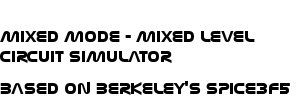Ngspice uses OSDI/OpenVAF for including Verilog-A compact device models
Since version 39 ngspice contains the OSDI interface. OSDI allows loading compiled Verilog-A compact device models at run-time. Advantages of this new approach are:
- All Verilog-A compact device models (from VA-Models, a collection of Verilog-A models preared for ngspice, from CMC, or from other sources) are now accessible by ngspice.
- User-provided Verilog-A compact device models may be compiled, loaded and simulated as well.
- Very fast model compilation with OpenVAF (around 2s, needed once per model, which then is usable for all subsequent simulations).
- Very efficient model execution in ngspice, including parallel evaluation.
- No code changes and re-compilation of ngspice required.
- Multiple models within a single simulation run are loaded on the fly.
Getting started with OSDI/OpenVAF
Several steps are necessary to add Verilog-A models to ngspice. Here you will find only a coarse to do list. A detailed description is available in the ngspice manual, chapter 13 (available as pdf or html).
- Get a Verilog-A compact model: There is a github repository VA-Models providing nearly all of the publicly available Verilog-A compact models. The models are checked against the LRM 2.4.0 Verilog AMS standard. CMC is another source. Or you may develop your own models!
- Obtain suitable model parameters.
- Obtain and install the OpenVAF compiler (Linux or MS Windows, no macOS for now).
- Compile the model with OpenVAF, obtaining a shared model library *.osdi.
- Load *.osdi into ngspice.
- Create your netlist, adding device lines starting with N for the *.osdi models.
- Run your simulation.
ADMS is declared deprecated
ADMS is no longer part of the ngspice development project. Its usage for integrating Verilog-A compact device models has been difficult. Its output often has been buggy, and there is no active maintenance available. It will be removed in a future ngspice release version.



